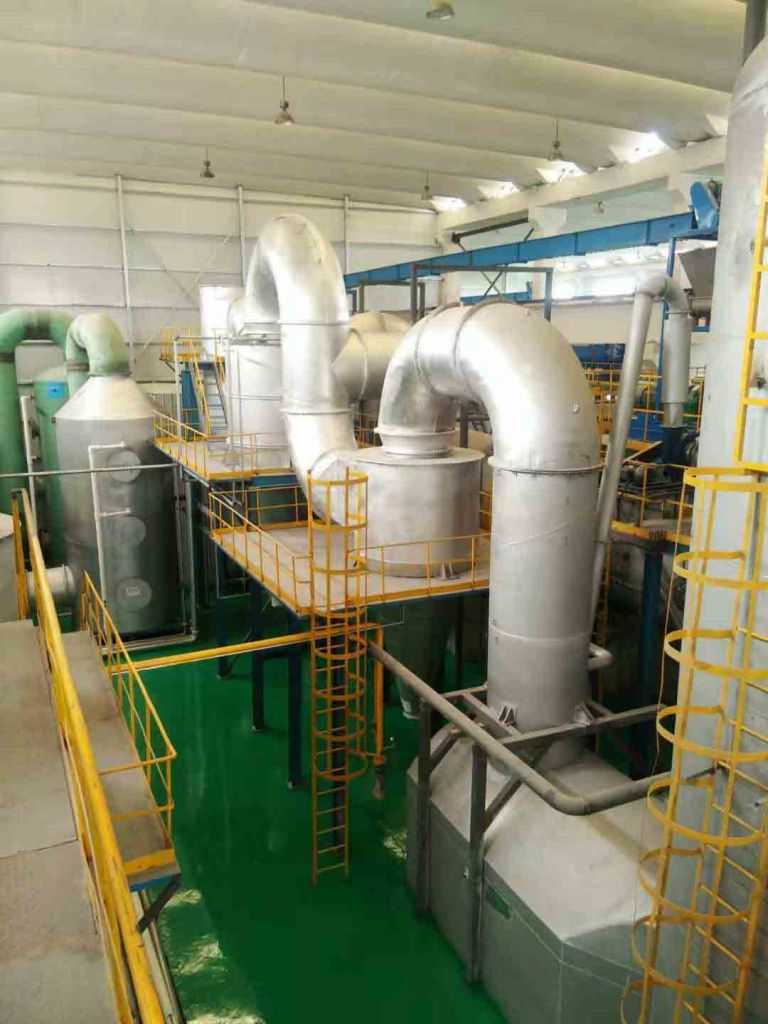Product Description
Carbonization is one of the most important process in the
production of activated carbon with gas-activating method. In the
process, materials are heated with a small amount of air to
eliminate non-carbon substances for producing carbonaceous
materials required for activation. Stack of carbonization furnace
consists of a material bin, a lifter, a feeder, stack,
refractories, a rotator, a waste heat boiler, a temperature
detector, a PLC cabinet, a cooler, a settling chamber, a fan, and a
device for dedusting and end-gas treatment. The carbonization
process is an integration of carbonization of materials and
treatment of end gas.
Carbonization
Carbonization is a process in which materials going through
destructive
distillation at low temperature. During the process, refractories
are heated by
radiation heat generated through combustion of fumes in chlorine.
Materials are
heated gradually in a low-temperature ambient isolated from air. At
this point,
materials are distributed on bottom of the furnace with a minor
exposure to
oxygen, and free of loss from ignition since the flames of fume
combustion are on
top. Lower molecular substances in materials are vaporized first
under radiation
heat, physical changes involved therein include dehydration,
degassing and
drying, and chemical changes include pyrolysis and condensation
polymerization.
Bonded groups of oxygen in organic compounds are broken, oxygen
separated
in forms of H2O, CO and CO2, and aromatic compounds and
cross-linked
high-hardness carbon- structures are formed. During carbonization,
oxygen,
hydrogen and other non-carbon are discharged in pyrolysis, and
ordered basic
graphite crystal structures are formed. The crystals are
combinations of irregularly
arranged carbon atom hexagons, leaving gaps as initial pores of
carbonized
materials. Therefore, carbonization forms secondary pores for
activations, and
provides mechanical hardness required for activation. Requirements
on material carbonization are results of carbonization.
Criterion on size and shape, initial pore structure and mechanical
hardness
are set for carbonized materials. Carbonization may be divided into
the following stages.
(1) Drying stage below **0°C. Internal and external moisture
contents of
materials are vaporized by external heat. No deformation of
materials at this
stage.
(2) Heat- absorption and pyrolysis stage between ******0°C.
Materials are
decomposed, releasing gaseous products (CO, C*2, H2 S). Change in
chemical composition of materials is started. Pyrolysis of various
materials are triggered at different temperatures. Pyrolysis of
material with lower metamorphic grade initiates at a lower
temperature.
(3) Carbonization stage between ******0°C. At this point,
fume temperature
in furnace may reach ******0°C. The stage involves mainly
condensation
polymerization and pyrolysis. A large quantity of volatile is
separated from
materials. Almost all tars, pyroligneous liquid and ethylene are
products of this
stage. Materials are softened and melted at this stage, forming
tristate plastic
mass, which will turn into semicoke after flowing, condensation
polymerization
and solidification.
Heating rate is the major operating condition in carbonization
process.
Heating rate significantly influence yield of carbonized products.
A higher
heating rate would increase tars and gas separated from materials,
but reduce
yield of carbonized materials. A lower heating rate would lead to a
prolonged
duration which offers pyrolysis with a high selectivity. Initial
pyrolysis breaks weak bonds in material molecular for concurrent
sequential condensation polymerization, forms structures with
higher thermal stability, and thereby reduce yield of volatiles
separated from high-temperature pyrolysis, achieving higher
productivity of solid carbonized products (carbonized materials).
Yield,
temperature and capacity are adjustable by controlling feeding
amount and
chloride amount.
Volatiles, carbon content, moisture content, as content and
hardness are major
indexes to evaluate quality of carbonized materials. Qualified
carbonized materials
shall be with a volatiles content of *2%**6%, a moisture content of
*5%- *5%, and
a ball-pan hardness of *0%.
As measurements of the above indexes are time-consuming, and
immediate
evaluation on carbonized materials are required in on-site
debugging for further
adjustments on parameters, visual inspection and evaluation are
acceptable.
Qualified carbonized materials shall have smooth and crack-free
surfaces, high
hardness and uniform sections.
Treatment of End Gas from Carbonization
End gas from carbonization consists of two parts, namely the high-
temperature
gas generated from external fuel combustion, including
CO2, H2O, N2 and traces of SO and CO, and volatiles generated from
pyrolysis of materials, including CO, H2, CH4, alkane, olefin and
tar. Traces of harmful substances could be found in
end gas from carbonization, which could cause air contamination
without proper
treatments. Therefore, such end gas has to be treated before
discharging to
atmosphere. Negative pressure must be applied for all processes
during such
adjustment, positive pressures may cause explosion.
With the burning method, end gas is induced into settling furnace
for
sufficient burning in an environment with excessive air at
*******0C, in which
combustible gases and toxic substances will be burnt into CO2 and
dumped.
Heat generated by the such combustions may be recycled by the waste
heat
boiler for vapor production. It is a low-cost simple method which
could eliminate
most of environmentally harmful substances, and generate vapor
required for
carbonization, therefore, the method is widely used in production
of activated
carbons.
| Country: |
China |
| Model No: |
Justfine-1003
|
| FOB Price: |
(Negotiable)
Get Latest Price
|
| Place of Origin: |
- |
| Price for Minimum Order: |
- |
| Minimum Order Quantity: |
1 Set |
| Packaging Detail: |
- |
| Delivery Time: |
- |
| Supplying Ability: |
- |
| Payment Type: |
- |
| Product Group : |
- |

